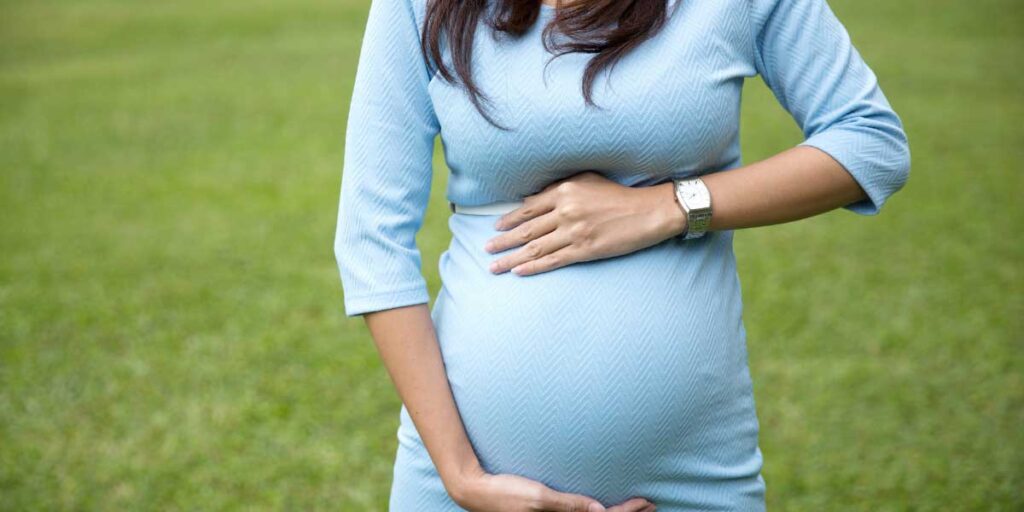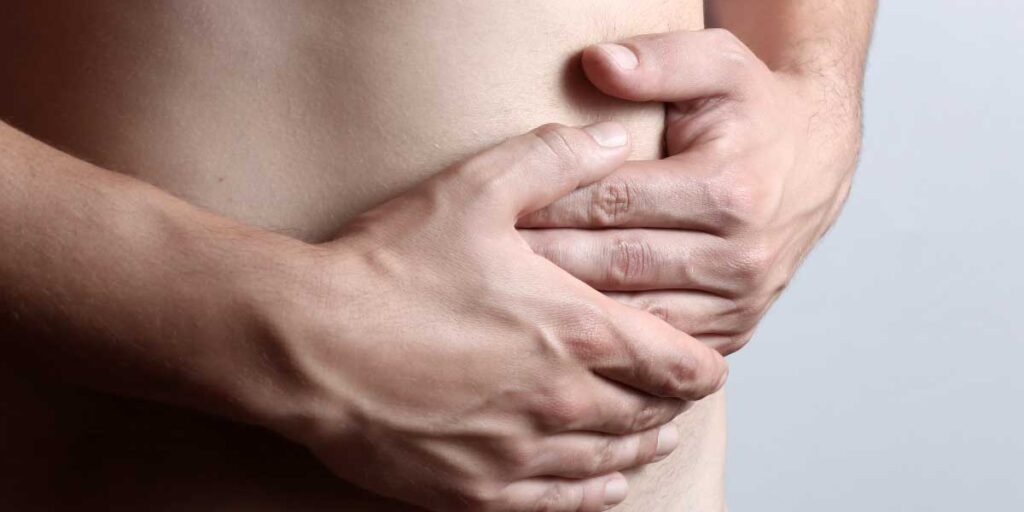Have you ever looked in the mirror and discovered something odd on your body?
For example, you notice a lump around the groin or belly button area. It is confusing whether this noticeable lump is risking your health or not.
Here is what you can try to do:
- Try to lie down and observe if the lump became smaller
- Touch the bump — Is it painful when you touch it?
If the lump made you uncomfortable and is aching, perhaps that is a hernia.
So, what exactly is a hernia?

Hernia Is A Common Disease
A hernia is a lump that usually exists around the groin, diaphragm or belly button. The cause of it is a weak abdominal wall.
The abdominal wall is the first layer of muscle that covers our stomach area. A weak abdominal wall that renders the organ underneath it falls out.
However, it does not fall off our bodies. Like our skin, it is thick enough to contain the organ.
A hernia can present at birth or develop in life. The overall rate of hernia (inguinal) in children is 3%; boys have a higher chance (6-10 times) to get it than girls. It frequently occurs in infants who are under one year old. The complication of hernia on children due to bowel caught in the hernia sac (big bulge near groin area) is 30%.
Men are more prone to get hernias than women. Accordingly to the statistic, abdominal hernias (inguinal hernias) happened more in men, with a lifetime risk of 27% and 3% in women. Therefore, it is more common to men rather than women.
The usual reason that causes a hernia is the wear and tears of the muscles. As we age, the risk to get a hernia is inherently higher. In addition, different types of hernias can develop in our bodies.
Let us continue to find out.

Types Of Hernias
The different affected areas will have other names. These included:
Epigastric – Around the stomach and starts from below the breastbone to above the belly button.
Umbilical – It locates a nearby belly button area. Children are easier to get, or some obese women or women who had given birth to many children.
Incisional – It locates anywhere that had a surgical cut around the stomach area.
Inguinal – Around the lower groin area (from the outside). Inside, it is around the inguinal canal. Both men and women have an inguinal canal.
- Men – it is a pathway for the spermatic cord and blood vessel that leads to testicles.
- Women – it provides support to the womb as there is a round ligament in it.
Femoral– Around the top inner thigh. It is a less common hernia that mainly occurs in older women.
Among these hernias, an inguinal hernia is the most common type of hernia that happens to people.
So, what is the cause of hernia?

The Causes Of Hernia
Wear And Tear Of Muscles
As mentioned above, our bodies inevitably get weaker over the years. As a result, adults are more susceptible to hernias.
Such as, if an adult has a labour intensive job, his muscles are consistently used for work. Eventually, the muscle elasticity gets weaker. Suppose our muscles should be stronger if they train them often. But we are talking about putting too much strain on the muscles.
The abdominal wall of a particular area (used for work) will get thinner. It also allows the muscle to stretch too much. Hence, an opening or a hole forms in the weakened area. And that causes the organ inside to fall out through the fatty layer and create a bulge.
It also applies to people who do weight lifting as well. For example, suppose a person did weight lifting without appropriately using the abdominal muscle. The same situation will happen again.
Unhealthy Lifestyle
Another reason for hernia is — an unhealthy lifestyle. Such as poor nutrition due to an unbalanced food diet. Without having enough nutrients in our body, it affects our muscles too.
Smoking is another possible cause as it affects body health. Obesity, too, threatens our health.
In short, if a person is too thin, their muscle endurance may be weak. The same goes for people who are obese, and their muscles might face difficulty supporting heavyweight.
Both scenarios weakened the strength, and it causes the muscle to form opening quickly. Then, it leads to the formation of a hernia.

Pregnancy
Pregnant women are at risk to get hernias. As their womb stretches a lot during the pregnancy. A womb is akin to a balloon. It expands while carrying a baby—the pressure inside strains the abdominal muscles.
As it stretches, the stomach wall’s muscle becomes weaker and thinner. If we look closely at pregnant women’s bellies, we can see that their belly button was bulging. That is the pushing force that comes from the baby inside.
Hence, when the endurance of the muscle around the womb compromises, it causes an umbilical hernia.
Others
Chronic constipation causes a hernia – extra pressure and force during the bowel movement cause straining to the muscles.
In simple words, pushing it too hard will burden the muscles. Smoking also might lead to chronic coughing. Chronic cough pulls and stretches our muscles constantly. Studies showed that cough induced hernia is possible but rare.
The Symptoms Of Hernia
The common symptoms are:
- Visible bulge or lump
- Pain or tenderness around the hernia site
- Pressure around the affected area
- Others
Usually, it causes pain and discomfort. Initially, notice the swelling worsens after standing or walking for long hours. It disappears or reduces in size after we lie flat.
People with hernia feel the hernia more when they stand up and less after they lie down. It is due to the change in gravity that affects the hernia site. Not all hernias are visible, but if they feel pain when lifting an object, it can be the cause.
Some hernias are reducible where we can push back the lump. Also, look out for the size of the swelling. If the size of the swelling gets significant over time, it is at a critical stage.
Besides observing these symptoms, how do we get to a diagnosis?

The Diagnosis Of Hernia
Typically, we can visit the general doctor in the clinic. The doctor will press the lump or ask the patient to cough. There are two possible outcomes from the clinic visit.
- No discomfort or pain — the doctor waits for watching since it is asymptomatic.
- Tenderness or pain is present — the doctor might order more tests to find out more about the lump.
Doctors will use other methods to diagnose the lump’s content properly. For example, they use scans such as ultrasound, CT scan, MRI, and X-ray.
After the diagnosis, what is next?
The Complication Of Hernias
Not all hernias require a surgical procedure. Some people carry hernias for their whole life since the hernia is not painful.
However, some hernias complicate and cause pain.
A hernia can trap and unable to return to its original place. It blocks the passage of the intestines. Also, it affects the blood supply that carries the nutrients and oxygen to the intestine. The affected intestine will cease to work. It is known as strangulation.
Such a condition is life-threatening and requires an emergency to prevent the death of the trapped organ.
Another complication that occurs due to an untreated hernia is incarceration. The intestines are stuck in the inguinal canal. It causes vomiting, nausea and aches in the groin.
Once the doctor confirmed the diagnosis, they will decide which surgical procedure to perform based on the patient’s diagnosis.

The Procedure
There is two common way to remove/fix hernia– open surgery and laparoscopic.
Open Surgery
Open surgery is the traditional surgery that requires the surgeon to open up our abdomen.
The surgeon finds the opening or hole on the muscle and uses a surgical mesh (similar to a net) to patch the weak spot. Then, they sew the mesh into a more vital tissue around the hernia site. It prevents the hole from reopening.[1]
Laparoscopic
In laparoscopic hernia repair, the surgeon makes two to three small incisions over the involved area. The surgeon inserts a laparoscope and surgical instruments through these incisions.
With the laparoscope, they can view the abdominal activity (inside our stomach). And it shows surrounding tissues with an external monitor screen (TV) while repairing the hernia.
The surgeon inflates the abdomen with carbon dioxide. So, he can visualize the hernia.
Then he clips or staples the mesh to the muscle around the hernia site, similar to open surgery.
Laparoscopic surgery has a few added advantages as compared to traditional ones. Recent studies showed that patient who underwent laparoscopic hernia repair returns to usual daily routine/activities sooner (about seven days). There are less pain and numbness too.
Conclusion
Hernia might seem problematic but is curable with the appropriate treatment. Some people carry hernias for a long time. As long as it does not cause pain, it is acceptable to leave it as it is.
However, if it starts to grow or hurt, consult a doctor for a general assessment first.
Once a complication arises, seek a general surgeon to remove it. Always be on the lookout for any lump or bulge on our body.
Book an appointment with me if you suspect you have a hernia.